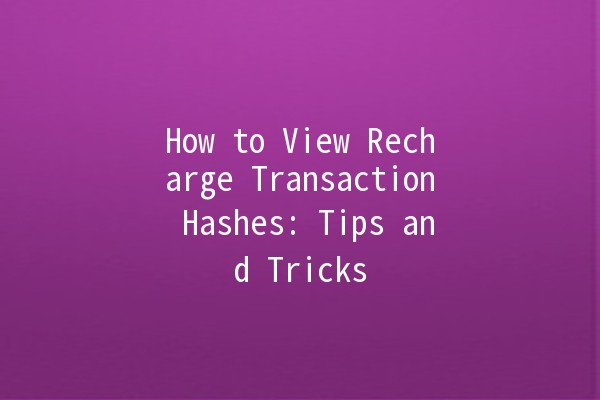




When engaging with digital currencies or online wallets, understanding how to track and verify your transactions is essential. One of the key aspects of this tracking is the transaction hash. This unique identifier gives you the ability to see details about your transaction, including its status, confirmation times, and more. In this article, we will delve into practical recommendations for viewing recharge transaction hashes, providing you with useful techniques and best practices to ensure you can effortlessly manage your transactions.

A transaction hash (often referred to as a tx hash) is a unique alphanumeric string generated when a transaction is processed on a blockchain. Each hash acts as a fingerprint for the transaction, allowing users to track its status and verify its authenticity. Whether you're sending or receiving cryptocurrency or recharging your digital wallets, every action generates a hash that can be accessed for verification.
The transaction hash serves several critical purposes:
Verification: It confirms whether a transaction has been executed successfully.
Transparency: It allows anyone to view the transaction details on the blockchain, promoting accountability.
Troubleshooting: If issues arise, like delayed transactions, the hash can help identify the problem.
Here are five practical tips to improve your competence in finding and utilizing transaction hashes:
Description: Blockchain explorers are online tools that allow users to search for transaction details directly on the blockchain.
Application: To view a transaction hash using a blockchain explorer, follow these steps:
Example: If you made a recharge using Ethereum, you can check your transaction by pasting the hash into Etherscan to see live updates.
Description: Most digital wallets maintain a record of transactions, including access to transaction hashes.
Application: Here's how to find transaction hashes in your wallet:
Example: In a wallet like Trust Wallet, after selecting the token you recharged, the transaction history will display relevant details alongside the hash.
Description: Configuring your wallet to send notifications regarding transaction status can be helpful.
Application: Many wallets and exchanges allow users to receive notifications about transaction updates. By enabling these notifications, you can automatically stay informed about the success or failure of a transaction.
Example: If you use Coinbase, you can set it to notify you when your transaction has been confirmed, providing the transaction hash directly in the notification.
Description: For developers or advanced users, utilizing APIs can automate transaction tracking.
Application: Many cryptocurrency platforms offer APIs that allow you to programmatically retrieve transaction details. Here's a simple approach:
Example: Using Python with the Blockchain.com API, you can write a script that fetches transaction details automatically based on a hash you input.
Description: Engaging with community members or a support team can often provide insights into transaction issues.
Application: If you're facing trouble retrieving a transaction hash or understanding its status, consider these steps:
Example: On platforms like Reddit, users often share hacks and tips regarding transaction tracking, which could reveal lesserknown tools to simplify the process.
The time it takes for a transaction hash to appear can vary depending on the network congestion and the fee paid for the transaction. Generally, if the transaction is successful, the hash should appear within a few minutes. However, during peak usage times, it can take longer.
If your transaction hash is not showing up, first ensure you entered the correct hash. If it still doesn't appear, check your wallet's status for confirmations. It may also be helpful to verify with the sending or receiving address to ensure the transaction has been initiated properly.
Unfortunately, a transaction hash is the primary method of tracking transactions on the blockchain. Without the hash, it may be challenging to find specific transaction details. However, sometimes you may find transaction information through the wallet's interface if logged in.
Confirmations signify the number of times a transaction has been verified and added to the blockchain by miners or validators. The higher the number of confirmations, the more secure the transaction is considered, as it becomes increasingly difficult to alter older transactions.
No, there is no limit to how many times you can check a transaction hash. Blockchain data is publicly accessible, so anyone can track a transaction at any time. Be mindful of entering the correct hash to avoid confusing results.
If you lose access to your wallet, recovering the transaction hash may be challenging. However, you can check your email for any notifications sent by your wallet provider or review any export backups you may have made. If backed by exchanges, you might also retrieve transaction details from their support.
By following these techniques and utilizing the available resources, you can effectively view and manage your recharge transaction hashes, enhancing your overall user experience in the cryptocurrency space. Engage actively with your digital wallets, keep informed of your transaction statuses, and leverage community knowledge to enrich your understanding of transaction management.